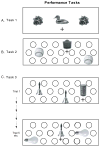The effects of selective hippocampal damage on tests of oddity in rhesus macaques
- PMID: 20882541
- PMCID: PMC3014996
- DOI: 10.1002/hipo.20827
The effects of selective hippocampal damage on tests of oddity in rhesus macaques
Abstract
The oddity task (e.g., A-, A-, B+) is classified as a conjunctive or relational task in which accurate performance depends upon learning to attend to stimulus relationships, not stimulus identity, and has no retention component as stimuli are presented simultaneously. It has been suggested that the hippocampus may play a particular role in learning this type of task in humans and animals. To test this, we trained adult rhesus macaques with selective neurotoxic damage to the hippocampal formation on their ability to learn and apply an oddity rule. The results suggest that the monkeys were able to adapt simple strategies to solve variations of the oddity task, however as the opportunity for such strategies was reduced, monkeys with hippocampal damage were increasingly impaired.
Copyright © 2010 Wiley-Liss, Inc.
Figures





Similar articles
-
Selective neurotoxic damage to the hippocampal formation impairs performance of the transverse patterning and location memory tasks in rhesus macaques.Hippocampus. 2005;15(1):118-31. doi: 10.1002/hipo.20037. Hippocampus. 2005. PMID: 15390158
-
Contrasting effects on discrimination learning after hippocampal lesions and conjoint hippocampal-caudate lesions in monkeys.J Neurosci. 2000 May 15;20(10):3853-63. doi: 10.1523/JNEUROSCI.20-10-03853.2000. J Neurosci. 2000. PMID: 10804225 Free PMC article.
-
Neurotoxic lesions of perirhinal cortex impair visual recognition memory in rhesus monkeys.Neuroreport. 2001 Jul 3;12(9):1913-7. doi: 10.1097/00001756-200107030-00029. Neuroreport. 2001. PMID: 11435922
-
On the role of the hippocampus in learning and memory in the rat.Behav Neural Biol. 1993 Jul;60(1):9-26. doi: 10.1016/0163-1047(93)90664-4. Behav Neural Biol. 1993. PMID: 8216164 Review.
-
Effects of aging on visual recognition memory in the rhesus monkey.Neurobiol Aging. 1988 Sep-Dec;9(5-6):495-502. doi: 10.1016/s0197-4580(88)80103-9. Neurobiol Aging. 1988. PMID: 3062461 Review.
Cited by
-
An MRI study of the corpus callosum in monkeys: Developmental trajectories and effects of neonatal hippocampal and amygdala lesions.Dev Psychobiol. 2017 May;59(4):495-506. doi: 10.1002/dev.21514. Epub 2017 Apr 3. Dev Psychobiol. 2017. PMID: 28369850 Free PMC article.
-
Stimulus similarity and encoding time influence incidental recognition memory in adult monkeys with selective hippocampal lesions.Learn Mem. 2011 Feb 25;18(3):170-80. doi: 10.1101/lm.2076811. Print 2011. Learn Mem. 2011. PMID: 21357439 Free PMC article.
-
Annual research review: The neurobehavioral development of multiple memory systems--implications for childhood and adolescent psychiatric disorders.J Child Psychol Psychiatry. 2014 Jun;55(6):582-610. doi: 10.1111/jcpp.12169. Epub 2013 Nov 29. J Child Psychol Psychiatry. 2014. PMID: 24286520 Free PMC article. Review.
-
Effects of selective neonatal hippocampal lesions on tests of object and spatial recognition memory in monkeys.Behav Neurosci. 2011 Apr;125(2):137-49. doi: 10.1037/a0022539. Behav Neurosci. 2011. PMID: 21341885 Free PMC article.
References
-
- Alvarado MC, Bachevalier J. Revisiting the maturation of medial temporal lobe memory functions in primates. Learning & Memory. 2000;7:244–256. - PubMed
-
- Alvarado MC, Bachevalier J. Selective neurotoxic damage to the hippocampal formation impairs performance of the transverse patterning and location memory tasks in rhesus macaques. Hippocampus. 2005;15(1):118–31. - PubMed
-
- Bachevalier J, Nemanic S. Memory for spatial location and object-place associations are differently processed by the hippocampal formation, parahippocampal areas TH/TF and perirhinal cortex. Hippocampus. 2009;18:64–80. - PubMed
-
- Barense MD, Gaffan D, Graham KS. The human medial temporal lobe processes online representations of complex objects. Neuropsychologia. 2007;45(13):2963–74. - PubMed
Publication types
MeSH terms
Substances
Grants and funding
LinkOut - more resources
Full Text Sources
Medical

